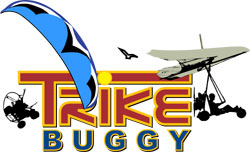

The Wind-Powered LandSail version of the TrikeBuggy is here!! Now you have another awesome way to cruise around when the wind starts to blow in the afternoon and you still want to play! The TrikeBuggy LandSailer components were designed from some of the popular and sucessful landsailers out ripping up the dry lake beds from El Mirage to Ivanpah, and from Mexico to the frozen lakes of Canada. Popular names like the Manta We use the Deluxe Flexifoil kite buggy as the base unit, then add a mast receptacle to the front steering mechanism that holds Maui's Hot Sails Junior Series Micro-Fire and Micro-Freak sails, masts and rigging, for their smaller size and incredibly efficient designs. The sail pictured above is only 1.6 sq meter, yet we were geting speeds of over 40 mph - plenty for that short axled buggy!
LandSailing in America began somewhere around the time I was born! Initially, a dingy sail was installed on something like a soap-box derby car, and the result was pretty exciting! Read more about these early days HERE. See also the page on Wikipedia - Land Sailing. From other Web resources: Landsailing is a very demanding sport requiring exceptional skills, eye-hand-leg co-ordination of a very high caliber, dexterity, mental perspicacity and high reflexes. There are many types of Landsailing crafts of which class – 3 and class – 5 are more often used. Controlling the craft requires controlling the sail the operation of which is almost akin to normal water boat. You are required to navigate with your legs and the sail you control with a sheet rope – just pull the rope to sheet in and refrain from pulling the rope for sheeting out. It has been well documented that sailboats have the potential to go faster than the accompanying wind! Land sailing crafts can reach 2 to 3 times the speed of the accompanying wind, of course, under ideal situations. Under normal wind conditions, a land sail may reach even 50 mph, but you can cruise within a safer speed of about 20 to 40 mph bracket. A landyacht that is sailing downwind can reach no greater a speed than that of the wind itself. But a landyacht can reach much faster speeds when it sails across the wind rather than being pushed along by it (actually it can go 5 times as fast as the wind), since the landyacht creates a wind from the velocity of its own movement that greatly supplements the natural wind. These principles were only vaguely understood in the early days of landsailing. The speed of the landyacht also depends on its type, landyachts that are built for the purpose of speed can go up to a speed of 100 mph! Landyachts come in many varieties. From home built landyachts, to mass produced by manufacturers. Most are made from aluminum and steel tubing, while others are made from high-tech composite materials such as carbon fiber. Many homemade landyacht sails are made from old windsurf boards or old sailboats. |
|
|---|
|
DISCLAIMER: Please read and be sure you thoroughly understand this disclaimer before flying a TrikeBuggy. Trike flying is an extremely demanding sport requiring exceptional levels of attention, judgment, maturity and self discipline. It is unlikely that you will be able to participate in it safely unless you make a conscious and continual commitment to your own safety. PPG and Hang Glider Trike flying is a dangerous sport and may result in injury and death even when practiced by a competent pilot using proper equipment. TrikeBuggies are not covered by product liability insurance, nor have they been designed, manufactured or tested to any federal or state government airworthiness standards or regulations. Do not fly them unless you are willing to assume personally all risks in the sport of Trike flying, and all responsibility for any property damage, injury, or death which may result from your use of this TrikeBuggy. Safe operation of the TrikeBuggy requires a pilot proficiency equivalent to that of a BFI (Basic Flight Instructor), as well as an equivalent level of knowledge and understanding of those wind and weather conditions which may compromise the pilot's safe control of the TrikeBuggy. In particular, be advised that gusty winds or turbulent conditions may interfere with even an expert pilot's ability to safely control the TrikeBuggy, and may cause it to crash. Never take anything for granted in Trike Flying. If you are in doubt about anything, stop and figure it out or contact TrikeBuggy. Also please read our Warning and Caution! |